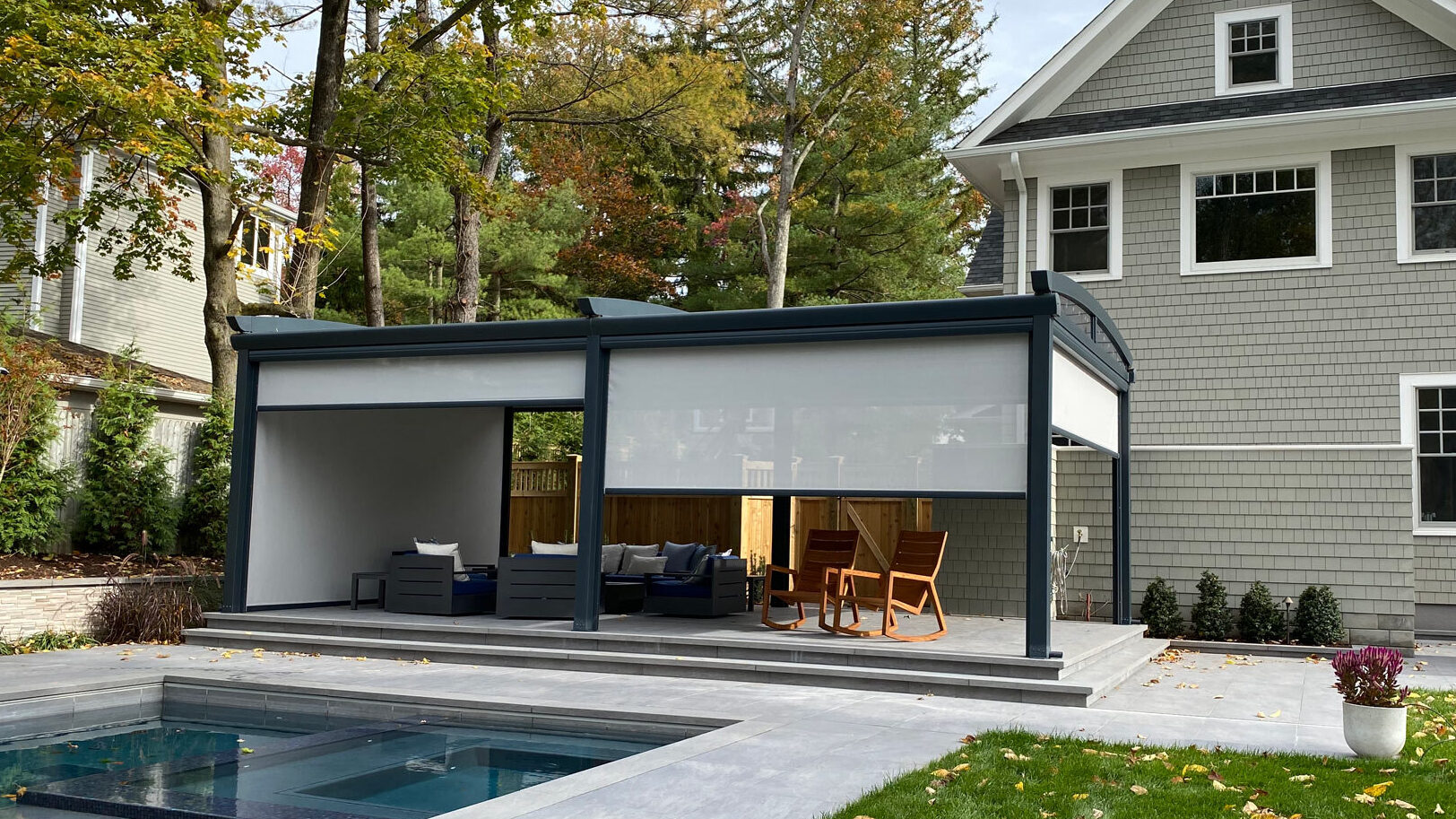🌿 Auswahl einer Pergola: Ihr Kaufratgeber für Aluminium-Pergola
💡 Warum ist dieser Artikel wichtig?
Die Wahl einer Pergola ist ein freudiger Moment, da sie Ihren Outdoor-Lebensstil völlig verändern kann – und einen kahlen Garten in eine luxuriöse Erweiterung Ihres Zuhauses verwandeln kann.
Wer zum ersten Mal eine Pergola kauft, kann bei der großen Auswahl an Materialien, Funktionen und Größen jedoch leicht kostspielige Fehler machen.
✅ Ihre ultimative Checkliste
Dieser Kaufratgeber für Aluminium-Pergola ist als Ihre ultimative Checkliste vor dem Kauf gedacht.
Zeichnen auf 20 Jahre Erfahrung in der Herstellung und im Vertrieb,
wir haben identifiziert neun Schlüsselfaktoren um sicherzustellen, dass Sie die perfekte Pergola auswählen.
📝 Neun Checkliste vor dem Pergola-Kauf
1️⃣ Genehmigungen der Hausbesitzervereinigung (HOA) und der Kommune

Dies ist der wichtigste erste Schritt. Ohne HOA oder kommunale Genehmigungen oder Genehmigungen,
selbst wenn Sie eine Pergola kaufen und installieren lassen, kann diese wegen Verstoßes gegen die Vorschriften entfernt werden!
✅ Standort: Kann es nur im Hinterhof gebaut werden oder kann es an der Seite des Hauses angebracht werden?
Wie weit muss der Abstand zum Nachbarzaun sein?
✅ Größe: Gibt es Einschränkungen hinsichtlich der Höhe der Pergola oder des Prozentsatzes des Gartens, den sie überdecken kann?
✅ Material und Farbe: In einigen Gemeinden der USA gelten strenge Vorschriften zur Wahrung eines einheitlichen Erscheinungsbildes.
Lesen Sie Ihren HOA-Vertrag und wenden Sie sich zunächst an Ihre örtliche Baubehörde.
👉 Um ein tieferes Verständnis des Genehmigungsprozesses zu erhalten, lesen Sie unseren vollständigen Leitfaden zu
Kosten für die Installation einer Pergola, das einen ausführlichen Abschnitt enthält.
2
Klimabedingungen (Haltbarkeitsprüfung)

Extreme Wetterbedingungen ist eine unvermeidliche Belastungsprobe für jede Außenkonstruktion. Die Wahl von Materialien, die diesen Extremen standhalten, ist eine verantwortungsvolle Investition.
🌧 Hohe Luftfeuchtigkeit/Regen: Holz verrottet, Stahl rostet. Aluminium bleibt unberührt.
❄️ Schneebedeckt: Hochfestes Aluminium ist so konstruiert, dass es hohen Schneelasten von bis zu 60–80 cm standhält.
🌊 Küstensalzgischt: Salz wirkt extrem korrosiv auf Stahl und Holz. Pulverbeschichtetes Aluminium in Marinequalität ist das einzige Material, das Salznebel zuverlässig standhält.
☀️ Starke UV-Strahlung/Sonnenlicht: Holz verblasst und reißt, und bei Stahl kommt es zu Verfärbungen und Oberflächenschäden durch die Beschichtung. Aluminium mit einer hochwertigen UV-beständigen Beschichtung behält hingegen über Jahrzehnte seine Farbe und Integrität.
✅ Aktionsschritt:
Passen Sie das Material Ihrer Pergola immer an Ihr lokales Klima an. Aluminium mit Schutzbeschichtungen bietet die längste Lebensdauer unter allen Bedingungen.
3
Der perfekte Standort (Platzierung ist entscheidend)

Wo möchten Sie die Pergola installieren? Der Standort bestimmt den besten Typ und Stil.
🏡 Hinterhof/Terrasse: Der am häufigsten verwendete Standort, perfekt für die Einrichtung eines Wohn- oder Essbereichs im Freien.
🏊 Poolseite: Erfordert ein hochkorrosionsbeständiges Material wie Aluminium, um Chlorspritzern standzuhalten.
🏢 Dachterrasse oder Balkon: Erfordert ein leichtes, aber dennoch stabiles Material und eine professionelle Bestätigung der Tragfähigkeit des Gebäudes.
📌 Aktionsschritt:
Entscheiden Sie sich zunächst für den Standort. Dadurch werden das richtige Material, der richtige Stil und die richtige Installationsmethode für Ihre Pergola direkt bestimmt.
4
Die richtige Größe Ihrer Pergola (passend zu Ihrem Garten)

Größer ist nicht immer besser. Eine Pergola sollte proportional zu Ihrem Platz sein.
📏 Kleiner Garten (<800 Quadratfuß): Entscheiden Sie sich für ein kompaktes Modell (z. B. 10 x 12 Fuß). Ein an der Wand befestigtes Modell kann wertvollen Platz am Boden sparen.
📐 Mittlerer Hof (800–1500 Quadratfuß): Eine Standard-Pergola mit den Maßen 12 x 16 Fuß eignet sich perfekt für ein komplettes Ess- oder Lounge-Set.
🏞️ Großer Garten (> 1500 Quadratfuß): Sie haben die Freiheit, ein großes, erweitertes Modell (16'x20' oder größer) zu verwenden, um ein echtes Outdoor-Ziel mit mehreren Zonen zu schaffen.
📌 Aktionsschritt:
Messen Sie zunächst Ihren Garten aus und passen Sie dann die Größe der Pergola an, um Ausgewogenheit und Nutzbarkeit zu gewährleisten, ohne Ihren Außenbereich zu überladen.
5
Installationsmethode (Freistehend vs. Angebaut vs. Aufgehängt)
Die Art der Verankerung der Pergola beeinflusst sowohl die Optik als auch die Kaufentscheidung?
🏡 Freistehend: Steht allein auf vier oder mehr Pfosten. Bietet die größte Flexibilität bei der Platzierung.
🏊 Beigefügt: Wird an die Außenwand Ihres Hauses angeschlossen. Schafft einen nahtlosen Übergang von drinnen nach draußen.
🏢 Federung: Macht die Pfosten überflüssig und stützt die Pergola mit einer Überkopfspannung, was zu einer offenen Sicht und einem eleganten Erscheinungsbild führt.
📌 Aktionsschritt:
Jede Methode hat einzigartige Vor- und Nachteile. Um sie im Detail zu erkunden, sehen Sie sich unsere Leitfaden für freistehende oder angebaute Pergolen.
6
Der Öffnungsmechanismus (manuell vs. elektrisch)

Welche Funktion soll Ihr Dach erfüllen?
📏 Manuelles Lamellendach: Ermöglicht Ihnen, die Lamellen manuell zu verstellen, um ein ausgewogenes Verhältnis von Sonne und Schatten zu erzielen. Eine großartige Option für preisbewusste Nutzer.
📐 Elektrisches bioklimatisches Dach: Das Nonplusultra an Luxus und Komfort. Steuern Sie die Lamellen per Fernbedienung. Oft sind auch intelligente Funktionen wie Regensensoren enthalten, die das Dach automatisch schließen.
7
Intelligente Funktionen und Add-ons (Die Upgrades)
Überlegen Sie sich von Anfang an, welche Upgrades Sie möchten, da es oft einfacher und günstiger ist, diese während der Herstellung zu integrieren.

1, Integrierte LED-Beleuchtung

2, Elektrisches Windschutzrollo

3, Rahmenlose Glastür

4, Wind- und Regensensor
📌 Aktionsschritt:
Jede Integration bietet unterschiedliche Funktionen.
Für einen detaillierteren Einblick lesen Sie unsere Analyse von 11 Hightech-Pergola-Funktionen.
8
Markenqualität und Garantie (langfristiger Wert)

Der Kauf einer Pergola ist keine einmalige Anschaffung, sondern eine langfristige Investition.
Die Wahl eines Herstellers mit einem guten Ruf und einem Engagement für Qualität ist entscheidend.
Eine zuverlässige Marke gewährleistet nicht nur eine stabile Leistung über viele Jahre hinweg, sondern bietet auch eine umfassende Garantie, die Ihnen Sicherheit und Vertrauen gibt.
Die Frage ist also: Wie bestimmen Sie die Zuverlässigkeit einer Marke?
Bei der Auswahl einer Pergola-Marke sollten Sie neben Aussehen und Preis auch die folgenden Aspekte berücksichtigen, um deren Vertrauenswürdigkeit zu bestimmen:
1. Marktreputation und Kundenbewertungen
Überprüfen Sie echte Bewertungen auf verschiedenen Plattformen, um die Vertrauenswürdigkeit zu bestätigen.
- Ansehen offiziellen Websites, Plattformen von Drittanbietern, Und sozialen Medien.
- Wenn Kunden regelmäßig berichten schneller After-Sales-Service, reibungslose Installation, Und langfristig stabiler Einsatz, Sie können sich sicher fühlen.
2. Fallstudien und Projekterfahrungen
Fälle aus der Praxis spiegeln die bewährte Leistung der Marke wider.
- Zuverlässige Hersteller teilen konkrete Projektbeispiele mit Bilder und Details.
- Wenn eine Marke erfolgreiche Fälle in lokalen oder ähnlichen Umgebungen, es ist ein starkes Zeichen der Glaubwürdigkeit.
3. Produktprüfung und Zertifizierung
Zertifizierungen belegen, dass das Produkt strenge Tests bestanden hat.
- Suchen Sie nach internationalen oder regionalen Standards wie CE, ISO, ASTM.
- Diese bestätigen, dass Materialien und Verarbeitung widerstehen langfristiger Nutzung und Umweltbelastungen.
4. Transparenz der Garantiebestimmungen
Die Klarheit der Garantie zeigt das Vertrauen der Marke.
- Überprüfen Sie nicht nur die Länge der Garantiezeit.
- Achten Sie darauf, ob es abdeckt Lackverfärbungen, elektrische Ausfälleoder einfach Strukturschäden.
5. Kundendienst und Support
Ein starker Service spiegelt das Engagement für die Kunden wider.
- Eine zuverlässige Marke bietet umfassender Kundenservice Und Installationsunterstützung.
- Bewerten Sie ihre Kommunikationseffizienz Und Geschwindigkeit der Problemlösung um die Zuverlässigkeit zu messen.
9
Langfristige Wartung (Die tatsächlichen Kosten)

Der Kaufpreis ist nur ein Teil der Geschichte.
Die langfristigen Betriebskosten sind ein entscheidender Kauffaktor.
Holzpergolen: Erfordert jährliches Beizen und Versiegeln ($300–$500/Jahr) und alle paar Jahre den Austausch verrotteter Bretter ($800+).
Stahlpergolen: Jährliche Rostinspektion und Neulackierung erforderlich ($200–$300/Jahr).
Aluminium-Pergolen: Erfordert nur gelegentliche Reinigung mit Wasser und Seife. Die langfristigen Wartungskosten betragen praktisch null, was es über die gesamte Lebensdauer des Produkts zur kostengünstigsten Lösung macht.
📌 Aktionsschritt:
Bevor Sie Ihre Pergola genießen, denken Sie an die langfristige Pflege. Unsere Anleitung zur Pergola-Wartung zeigt Ihnen, wie Sie dafür sorgen, dass es wie neu aussieht und funktioniert.
Ihr Kauf ist ein Plan, nicht nur ein Produkt
Indem wir durch dieses 9-Punkte-Checkliste, Sie haben sich vom Käufer zum Planer entwickelt.
Sie verfügen nun über das nötige Wissen, um eine Pergola auszuwählen, die nicht nur am ersten Tag schön aussieht, sondern auch
passt zu Ihrem Lebensstil und hält Jahrzehnte.
Sehen Sie, wie diese Faktoren zusammenkommen in unserem Ultimativer Pergola-Kostenleitfaden 2025.


